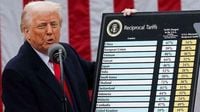In a significant shift in international trade policy, President Donald Trump has announced the implementation of high reciprocal tariffs under the "Make America Wealthy Again" program, which is set to impact various countries, including Indonesia. The tariffs, which are delayed for 90 days until June 2025, aim to address trade practices perceived as detrimental to the U.S. economy. Indonesia, now facing tariffs of up to 32%, is expected to bear the brunt of these changes, particularly affecting its export sectors.
According to Sutiyana, Chairman of the Sustainable Palm Oil Farmers Forum (FORTASBI), Indonesia has enjoyed a trade surplus with the United States, especially in textiles, footwear, and palm oil. The U.S. is Indonesia's second-largest trading partner after China, contributing approximately 10.5% of the nation's total exports. Data from the United States Department of Agriculture (USDA) shows that Indonesian tropical oil exports reached USD 2.13 billion in 2023, surpassing both the Philippines and Malaysia, with Indonesia controlling over 70% of U.S. tropical oil imports, marking the highest record since 2010.
However, the newly imposed tariffs threaten to reverse this trend. The planned tariffs could lead U.S. consumers to switch to cheaper alternatives, thereby reducing demand for Indonesian palm oil. Farmers are likely to face higher indirect taxes when selling fresh fruit bunches (TBS), further complicating their economic situation. Sutiyana emphasized that these tariffs could burden farmers, leading to lower prices for TBS and potentially decreasing their production motivation, which could harm the country’s foreign exchange earnings.
In a broader context, the "Liberation Day Tariffs" introduced by Trump not only reflect economic decisions but are also influenced by domestic political factors. The increase in base tariffs by 10% for all countries, alongside an additional 32% for specific nations like Indonesia, is seen as a move to bolster domestic industries and garner support ahead of upcoming elections. Critics argue that such protectionist policies create market imbalances and worsen global sentiment towards free trade, particularly affecting developing nations that heavily rely on export markets.
Dhany Surya Ratana and Theresia Anindita from the Jurnal SNMIP highlighted that these protectionist measures limit growth opportunities for developing countries, particularly those lacking robust domestic markets. The 32% tariff increase on Indonesia's key export products—textiles, rubber, electronics, and footwear—will likely inflate prices in the U.S. market, severely diminishing the competitiveness of Indonesian goods compared to countries like Vietnam and Bangladesh, which are not subjected to such high tariffs.
Reports from ASEAN Briefing (2025) indicate that Indonesia's textile and footwear industries are particularly vulnerable, with over 30% of their exports directed to the U.S. market. Without prompt policy responses from the government, these labor-intensive sectors could face significant slowdowns and even mass layoffs. The tariffs not only threaten trade balances but also endanger the labor market, given that many manufacturing jobs in Indonesia are linked to export activities.
In response to the tariff pressures, Minister Coordinator of Economic Affairs, Airlangga Hartarto, announced plans for Indonesia to increase imports from the U.S. by USD 19 billion, particularly in the energy and agriculture sectors. While this strategy aims to alleviate tariff pressures, it carries substantial fiscal risks and may widen the trade deficit if not accompanied by an increase in export capacity in other sectors.
Moreover, the fisheries sector in Indonesia, which is the fourth-largest supplier of seafood to the U.S., is also feeling the effects of Trump's tariff policies. The U.S. market is crucial for Indonesian fisheries, with shrimp exports valued at USD 1.08 billion, followed by crabs and lobsters at USD 362 million, and tuna at USD 254 million. The 32% tariff could pose a serious threat to the future of these exports, prompting the Indonesian government to seek alternative markets in Japan, China, Europe, and the Middle East.
Doni Ismanto Darwin, Special Staff to the Minister of Marine Affairs and Fisheries, noted that the U.S. is one of Indonesia's largest seafood markets, and the tariffs could challenge the stability of trade in this sector. He emphasized the need to diversify export markets and improve the quality and traceability of fisheries products to maintain competitiveness.
As the government prepares to navigate these turbulent waters, there are calls for strategic, medium- to long-term measures. Utilizing adaptive monetary policies, such as lowering interest rates and intervening in foreign exchange markets, could help stabilize the economy. Additionally, there is a pressing need for Indonesia to diversify its export base, promote non-traditional export programs, and expand access to new markets through free trade agreements.
Indonesia's membership in BRICS presents an opportunity to strengthen trade relations with major economies like China, India, and Russia. Active economic diplomacy and free trade agreements could mitigate the impacts of U.S. protectionism and enhance Indonesia's position in the global market.
Furthermore, internal market strengthening through local consumption and import substitution programs can bolster resilience against external shocks. Specific support for small and medium enterprises (SMEs) and labor-intensive industries most affected by high tariffs is crucial for maintaining employment and sustaining export activities.
In summary, while the immediate effects of Trump's tariffs pose significant challenges for Indonesia, they also provide an impetus for necessary reforms. The country must not only seek new export markets but also ensure that its domestic industries are resilient and capable of thriving in a competitive global environment. This multifaceted approach will be vital for Indonesia to navigate the complexities of international trade and safeguard its economic future.




